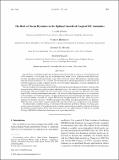The Role of Ocean Dynamics in the Optimal Growth of Tropical SST Anomalies
Author(s)
Zanna, Laure; Heimbach, Patrick; Moore, Andrew M.; Tziperman, Eli
DownloadZanna-2010-The Role of Ocean Dy.pdf (1.855Mb)
PUBLISHER_POLICY
Publisher Policy
Article is made available in accordance with the publisher's policy and may be subject to US copyright law. Please refer to the publisher's site for terms of use.
Terms of use
Metadata
Show full item recordAbstract
The role of ocean dynamics in optimally exciting interannual variability of tropical sea surface temperature (SST) anomalies is investigated using an idealized-geometry ocean general circulation model. Initial temperature and salinity perturbations leading to an optimal growth of tropical SST anomalies, typically arising from the nonnormal dynamics, are evaluated. The structure of the optimal perturbations is characterized by relatively strong deep salinity anomalies near the western boundary generating a transient amplification of equatorial SST anomalies in less than four years.
The associated growth mechanism is linked to the excitation of coastal and equatorial Kelvin waves near the western boundary following a rapid geostrophic adjustment owing to the optimal initial temperature and salinity perturbations. The results suggest that the nonnormality of the ocean dynamics may efficiently create large tropical SST variability on interannual time scales in the Atlantic without the participation of air–sea processes or the meridional overturning circulation. An optimal deep initial salinity perturbation of 0.1 ppt located near the western boundary can result in a tropical SST anomaly of approximately 0.45°C after nearly four years, assuming the dynamics are linear. Possible mechanisms for exciting such deep perturbations are discussed. While this study is motivated by tropical Atlantic SST variability, its relevance to other basins is not excluded.
The optimal initial conditions leading to the tropical SST anomalies’ growth are obtained by solving a generalized eigenvalue problem. The evaluation of the optimals is achieved by using the Massachusetts Institute of Technology general circulation model (MITgcm) tangent linear and adjoint models as well the the Arnoldi Package (ARPACK) software for solving large-scale eigenvalue problems.
Date issued
2010-05Department
Massachusetts Institute of Technology. Department of Earth, Atmospheric, and Planetary SciencesJournal
Journal of Physical Oceanography
Publisher
American Meteorological Society
Citation
Zanna, Laure, Patrick Heimbach, Andrew M. Moore, and Eli Tziperman. "The Role of Ocean Dynamics in the Optimal Growth of Tropical SST Anomalies." J. Phys. Oceanogr., 40.5, 983–1003. 2010. © 2010 American Meteorological Society.
Version: Final published version
ISSN
0022-3670
1520-0485